KIA Spectra 2009 2.G Repair Manual
Manufacturer: KIA, Model Year: 2009, Model line: Spectra, Model: KIA Spectra 2009 2.GPages: 291, PDF Size: 2.63 MB
Page 61 of 291

351
1
2
3
4
5
6
7
8
9
Knowing your vehicle
What your air bag system
doesDriver’s air bag and front passen-
ger’s air bag are designed to supple-
ment the protection offered by the
safety belt in certain frontal colli-
sions. Likewise, side air bag and cur-
tain air bags are designed to supple-
ment the protection offered by the
safety belt in side collisions. Safety
belts are designed to reduce the
injury of the driver or passengers in
case of impact or collision. No safety
belt or air bag system can complete-
ly eliminate injuries that may cause
in collisions or impacts. To help
reduce impact on driver or passen-
gers in any collision, safety belts
must be correctly worn.
What your air bag system
does not doThe air bag system is designed to
supplement the protection offered by
the safety belt system.IT IS NOT A
SUBSTITUTE FOR THE SAFETY
BELT.
The importance of using
safety beltsThere are four very important rea-
sons to use safety belts even with an
air bag supplemental restraint sys-
tem. They:
help keep you in the proper posi- tion (away from the air bag) when it
inflates.
reduce the risk of harm in rollover, side impact (vehicles not equipped
with side and curtain air bags) or
rear impact collisions, because an
air bag is not designed to inflate in
such situations and even a side
curtain air bag is designed to
inflate only in certain side impact
collisions.
reduce the risk of harm in frontal or side collisions which are not
severe enough to actuate the air
bag supplemental restraint system.
reduce the risk of being ejected from your vehicle.
Page 62 of 291
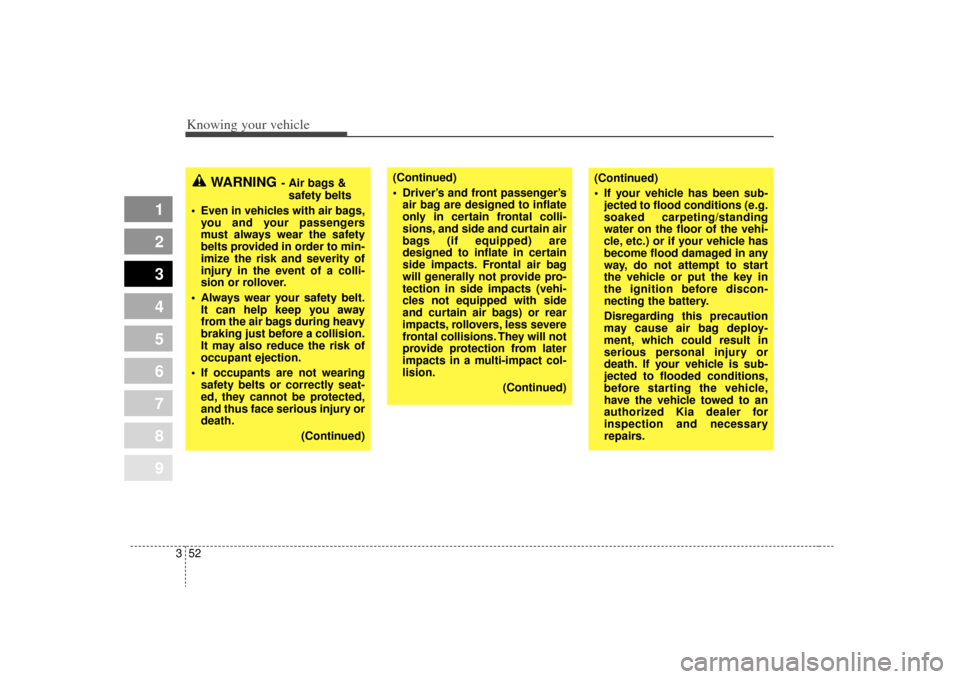
Knowing your vehicle52
3
1
2
3
4
5
6
7
8
9
WARNING
- Air bags &
safety belts
Even in vehicles with air bags, you and your passengers
must always wear the safety
belts provided in order to min-
imize the risk and severity of
injury in the event of a colli-
sion or rollover.
Always wear your safety belt. It can help keep you away
from the air bags during heavy
braking just before a collision.
It may also reduce the risk of
occupant ejection.
If occupants are not wearing safety belts or correctly seat-
ed, they cannot be protected,
and thus face serious injury or
death.
(Continued)
(Continued)
Driver’s and front passenger’sair bag are designed to inflate
only in certain frontal colli-
sions, and side and curtain air
bags (if equipped) are
designed to inflate in certain
side impacts. Frontal air bag
will generally not provide pro-
tection in side impacts (vehi-
cles not equipped with side
and curtain air bags) or rear
impacts, rollovers, less severe
frontal collisions. They will not
provide protection from later
impacts in a multi-impact col-
lision.
(Continued)
(Continued)
If your vehicle has been sub-jected to flood conditions (e.g.
soaked carpeting/standing
water on the floor of the vehi-
cle, etc.) or if your vehicle has
become flood damaged in any
way, do not attempt to start
the vehicle or put the key in
the ignition before discon-
necting the battery.
Disregarding this precaution
may cause air bag deploy-
ment, which could result in
serious personal injury or
death. If your vehicle is sub-
jected to flooded conditions,
before starting the vehicle,
have the vehicle towed to an
authorized Kia dealer for
inspection and necessary
repairs.
Page 63 of 291

353
1
2
3
4
5
6
7
8
9
Knowing your vehicle
Air bag system components The main components of your SRS
are:
To indicate that your vehicle isequipped with air bags, the corre-
sponding air bag covers are
marked with “SRS AIR BAG”.
- Driver’s air bag
- Passenger’s air bag
- Side air bag
- Curtain air bag
A diagnostic system that continual- ly monitors the system operation.
An indicator light to warn you of a possible problem with the system.
Emergency power backup in case your car’s electrical system is dis-
connected in a crash.
Driver’s air bagYour vehicle is equipped with a
Supplemental Restraint (Air Bag)
System and lap/shoulder belts at
both the driver and passenger seat-
ing position.
The driver’s air bag is stored in the
center of the steering wheel.
CAUTION
If the SRS air bag warning lightdoes not illuminate when theignition key is turned to the"ON" position, if it remains illu-minated after blinking forapproximately 6 seconds, or if itilluminates while the vehicle isbeing driven, have an author-ized Kia dealer inspect yourvehicle as soon as possible.
HLZ2120OLD026048
Page 64 of 291
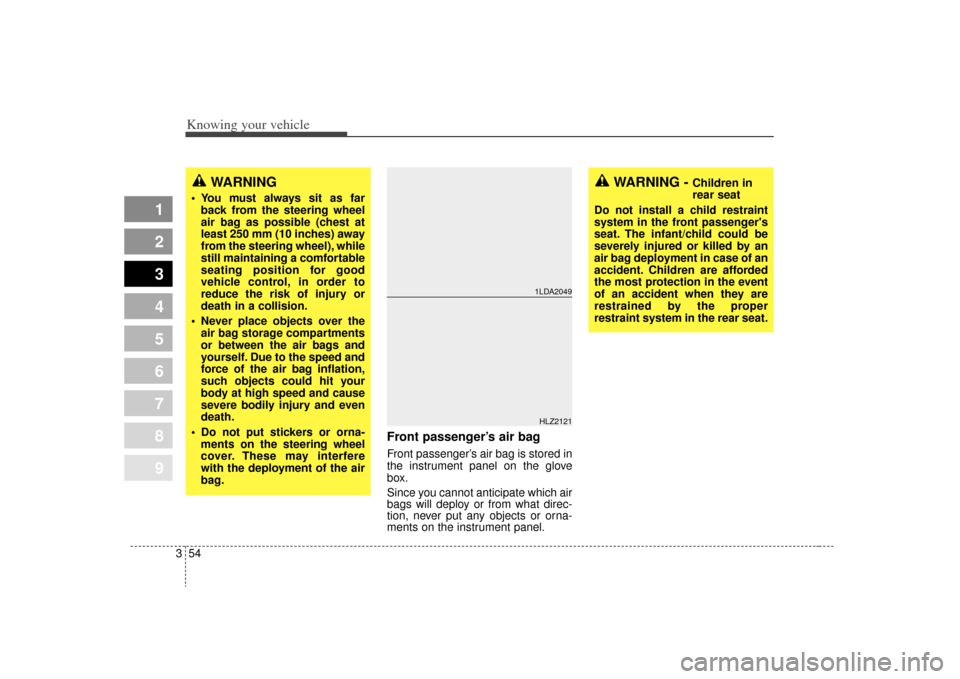
Knowing your vehicle54
3
1
2
3
4
5
6
7
8
9
Front passenger’s air bagFront passenger’s air bag is stored in
the instrument panel on the glove
box.
Since you cannot anticipate which air
bags will deploy or from what direc-
tion, never put any objects or orna-
ments on the instrument panel.
WARNING
You must always sit as far
back from the steering wheel
air bag as possible (chest at
least 250 mm (10 inches) away
from the steering wheel), while
still maintaining a comfortable
seating position for good
vehicle control, in order to
reduce the risk of injury or
death in a collision.
Never place objects over the air bag storage compartments
or between the air bags and
yourself. Due to the speed and
force of the air bag inflation,
such objects could hit your
body at high speed and cause
severe bodily injury and even
death.
Do not put stickers or orna- ments on the steering wheel
cover. These may interfere
with the deployment of the air
bag.
1LDA2049HLZ2121
WARNING -
Children in
rear seat
Do not install a child restraint
system in the front passenger's
seat. The infant/child could be
severely injured or killed by an
air bag deployment in case of an
accident. Children are afforded
the most protection in the event
of an accident when they are
restrained by the proper
restraint system in the rear seat.
Page 65 of 291
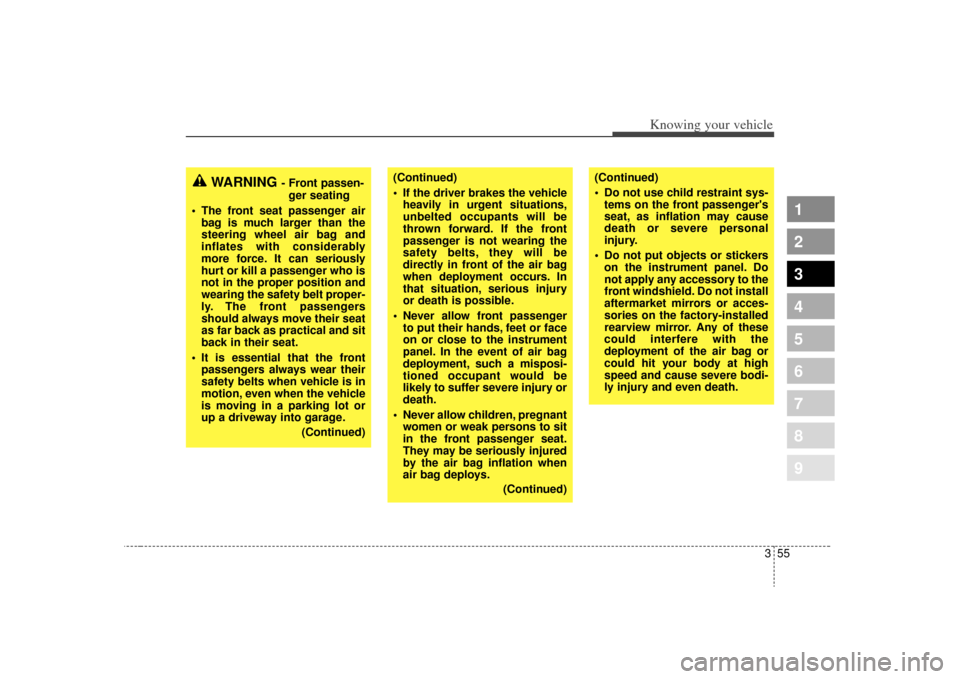
355
1
2
3
4
5
6
7
8
9
Knowing your vehicle
WARNING
- Front passen-ger seating
The front seat passenger air bag is much larger than the
steering wheel air bag and
inflates with considerably
more force. It can seriously
hurt or kill a passenger who is
not in the proper position and
wearing the safety belt proper-
ly. The front passengers
should always move their seat
as far back as practical and sit
back in their seat.
It is essential that the front passengers always wear their
safety belts when vehicle is in
motion, even when the vehicle
is moving in a parking lot or
up a driveway into garage.
(Continued)
(Continued)
If the driver brakes the vehicleheavily in urgent situations,
unbelted occupants will be
thrown forward. If the front
passenger is not wearing the
safety belts, they will be
directly in front of the air bag
when deployment occurs. In
that situation, serious injury
or death is possible.
Never allow front passenger to put their hands, feet or face
on or close to the instrument
panel. In the event of air bag
deployment, such a misposi-
tioned occupant would be
likely to suffer severe injury or
death.
Never allow children, pregnant women or weak persons to sit
in the front passenger seat.
They may be seriously injured
by the air bag inflation when
air bag deploys.
(Continued)
(Continued)
Do not use child restraint sys-tems on the front passenger's
seat, as inflation may cause
death or severe personal
injury.
Do not put objects or stickers on the instrument panel. Do
not apply any accessory to the
front windshield. Do not install
aftermarket mirrors or acces-
sories on the factory-installed
rearview mirror. Any of these
could interfere with the
deployment of the air bag or
could hit your body at high
speed and cause severe bodi-
ly injury and even death.
Page 66 of 291
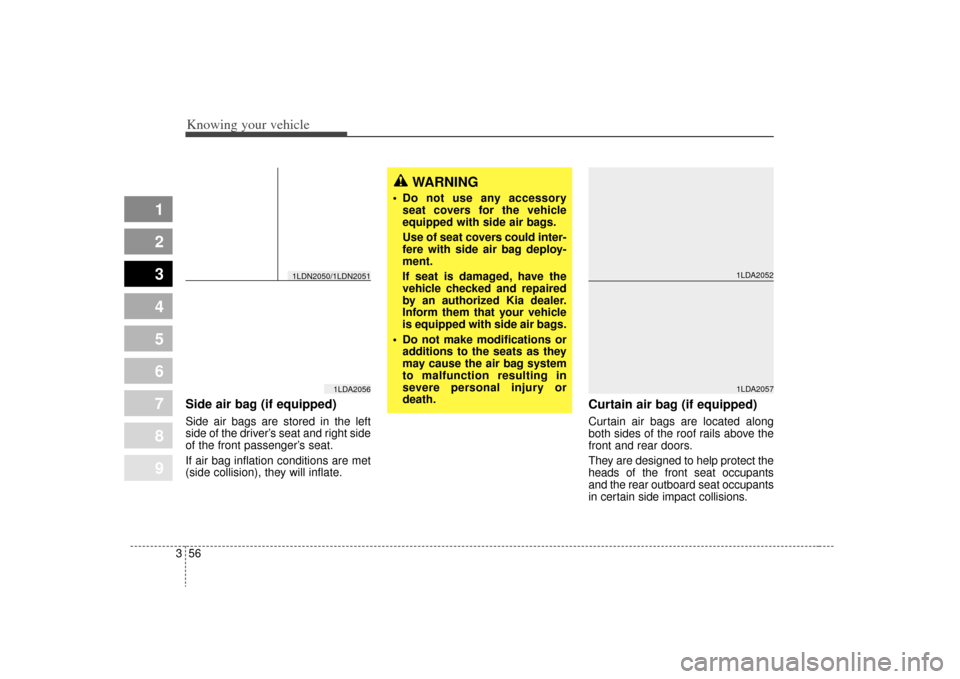
Knowing your vehicle56
3
1
2
3
4
5
6
7
8
9
Side air bag (if equipped)Side air bags are stored in the left
side of the driver’s seat and right side
of the front passenger’s seat.
If air bag inflation conditions are met
(side collision), they will inflate.
Curtain air bag (if equipped)Curtain air bags are located along
both sides of the roof rails above the
front and rear doors.
They are designed to help protect the
heads of the front seat occupants
and the rear outboard seat occupants
in certain side impact collisions.
1LDA2056
1LDN2050/1LDN2051
WARNING
Do not use any accessory
seat covers for the vehicle
equipped with side air bags.
Use of seat covers could inter-
fere with side air bag deploy-
ment.
If seat is damaged, have the
vehicle checked and repaired
by an authorized Kia dealer.
Inform them that your vehicle
is equipped with side air bags.
Do not make modifications or additions to the seats as they
may cause the air bag system
to malfunction resulting in
severe personal injury or
death.
1LDA20521LDA2057
Page 67 of 291
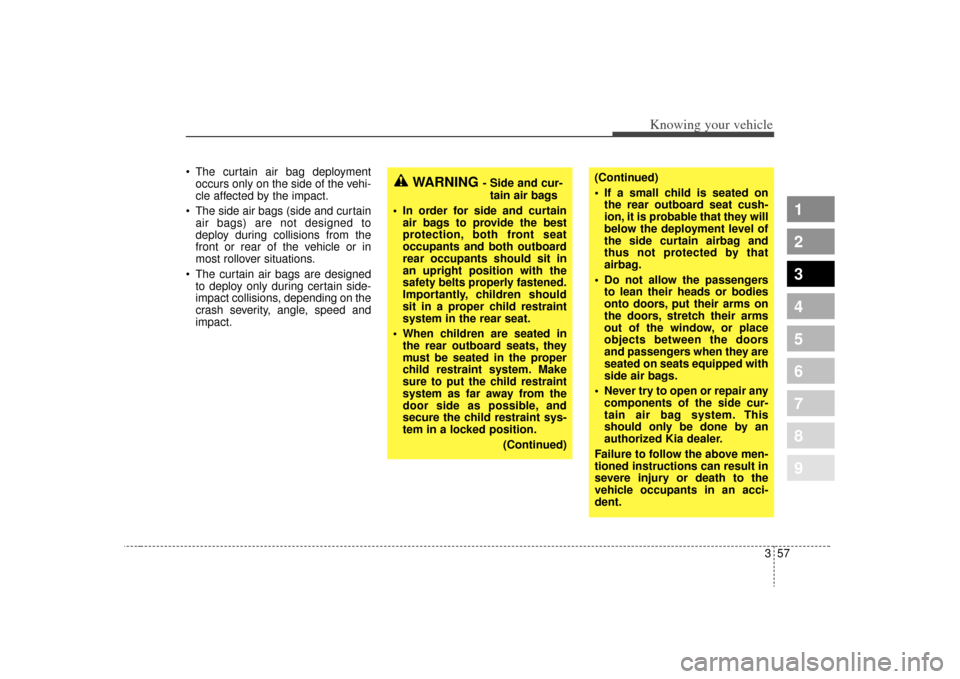
357
1
2
3
4
5
6
7
8
9
Knowing your vehicle
WARNING
- Side and cur-tain air bags
In order for side and curtain air bags to provide the best
protection, both front seat
occupants and both outboard
rear occupants should sit in
an upright position with the
safety belts properly fastened.
Importantly, children should
sit in a proper child restraint
system in the rear seat.
When children are seated in the rear outboard seats, they
must be seated in the proper
child restraint system. Make
sure to put the child restraint
system as far away from the
door side as possible, and
secure the child restraint sys-
tem in a locked position.
(Continued)
(Continued)
If a small child is seated onthe rear outboard seat cush-
ion, it is probable that they will
below the deployment level of
the side curtain airbag and
thus not protected by that
airbag.
Do not allow the passengers to lean their heads or bodies
onto doors, put their arms on
the doors, stretch their arms
out of the window, or place
objects between the doors
and passengers when they are
seated on seats equipped with
side air bags.
Never try to open or repair any components of the side cur-
tain air bag system. This
should only be done by an
authorized Kia dealer.
Failure to follow the above men-
tioned instructions can result in
severe injury or death to the
vehicle occupants in an acci-
dent.
The curtain air bag deployment
occurs only on the side of the vehi-
cle affected by the impact.
The side air bags (side and curtain air bags) are not designed to
deploy during collisions from the
front or rear of the vehicle or in
most rollover situations.
The curtain air bags are designed to deploy only during certain side-
impact collisions, depending on the
crash severity, angle, speed and
impact.
Page 68 of 291

Knowing your vehicle58
3
1
2
3
4
5
6
7
8
9
Why didn’t my air bag go off in
a collision? (Inflation and non-inflation condi-
tions of the air bag)There are many types of accidents in
which the air bag would not be
expected to provide additional pro-
tection.
These include rear impacts, second
or third collisions in multiple impact
accidents, as well as low speed
impacts. In other words, just because
your vehicle is damaged and even if
it is totally unusable, don’t be sur-
prised that the air bags did not
inflate.
OJB038512/OMG035052/OMG035053/OMG035055
1
2
Air bag collision sensors(1) SRS control module
(2) Side impact sensor (if equipped)
Page 69 of 291
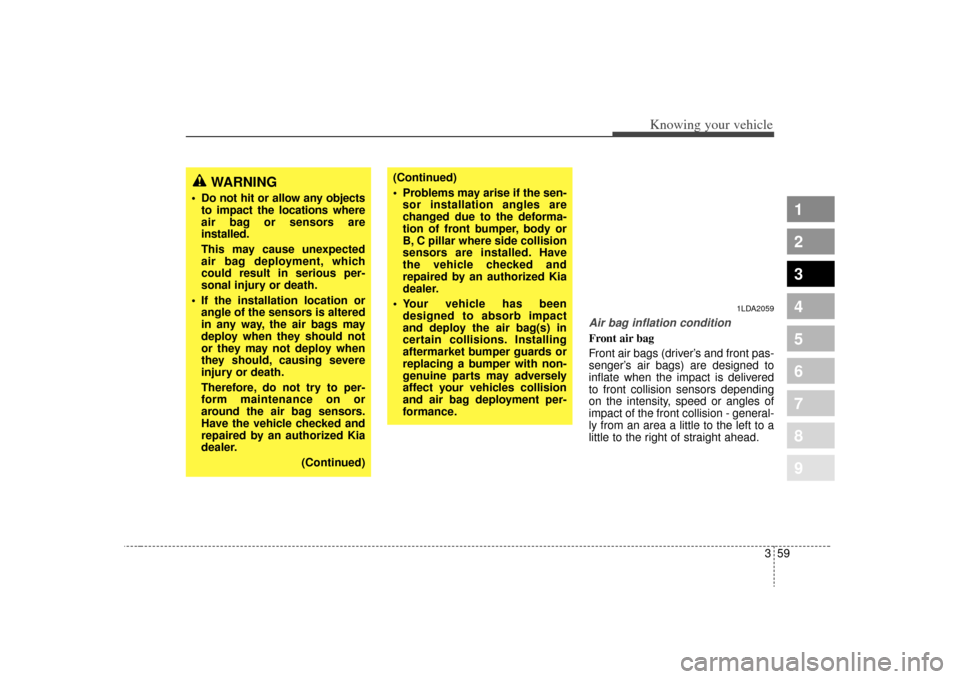
359
1
2
3
4
5
6
7
8
9
Knowing your vehicle
Air bag inflation conditionFront air bag
Front air bags (driver’s and front pas-
senger’s air bags) are designed to
inflate when the impact is delivered
to front collision sensors depending
on the intensity, speed or angles of
impact of the front collision - general-
ly from an area a little to the left to a
little to the right of straight ahead.
WARNING
Do not hit or allow any objectsto impact the locations where
air bag or sensors are
installed.
This may cause unexpected
air bag deployment, which
could result in serious per-
sonal injury or death.
If the installation location or angle of the sensors is altered
in any way, the air bags may
deploy when they should not
or they may not deploy when
they should, causing severe
injury or death.
Therefore, do not try to per-
form maintenance on or
around the air bag sensors.
Have the vehicle checked and
repaired by an authorized Kia
dealer.
(Continued)
(Continued)
Problems may arise if the sen-sor installation angles are
changed due to the deforma-
tion of front bumper, body or
B, C pillar where side collision
sensors are installed. Have
the vehicle checked and
repaired by an authorized Kia
dealer.
Your vehicle has been designed to absorb impact
and deploy the air bag(s) in
certain collisions. Installing
aftermarket bumper guards or
replacing a bumper with non-
genuine parts may adversely
affect your vehicles collision
and air bag deployment per-
formance.
1LDA2059
Page 70 of 291

Knowing your vehicle60
3
1
2
3
4
5
6
7
8
9
Side air bag (if equipped)
Side air bags (side and curtain air
bags) are designed to inflate when
an impact is detected by side colli-
sion sensors depending on the
strength, speed or angles of impact
of side impact collision or rollover by
the side impact. Although the front air bags (driver’s
and front passenger’s air bags) are
designed to inflate only in frontal col-
lision, it may inflate in any collision if
front impact sensors detect a suffi-
cient impact. Side air bags (side and
curtain air bags) are designed to
inflate only in side impact collision, it
may inflate in any collision if side
impact sensors detect a sufficient
impact.
If the vehicle chassis is impacted by
bumps or objects on unimproved
roads or sidewalks, air bags may
deploy. Drive carefully on unim-
proved roads or on surfaces not
designed for vehicle traffic.
To protect occupants, front air bags
or pre-tensioner safety belts may
deploy in certain side impact colli-
sions.
1JBA3514OUN026090